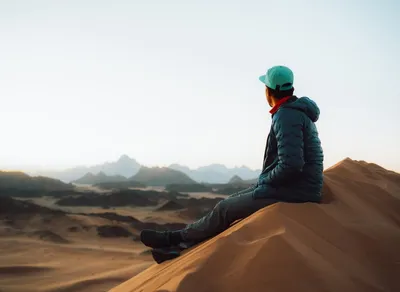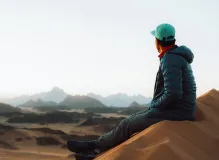For over long years, we have diligently conducted independent research and product testing. When you make a purchase through our links, we may earn a commission.
The Ultimate Guide to Trekking and Wilderness Survival
Created: 10 minutes ago

11 min Read
Are you an adventure lover? Have you ever dreamt of exploring the untouched beauty of nature? If so, trekking is the perfect outdoor activity for you. Trekking allows you to experience the thrill of navigating through breathtaking landscapes, challenging terrains, and remote wilderness areas. However, trekking can also pose certain risks and challenges, especially when it comes to hiker safety and emergency preparedness. In this comprehensive guide, we will explore the world of trekking, focusing on everything from essential hiking gear to wilderness survival techniques. So, grab your hiking boots, pack your backpack, and let's embark on a memorable wilderness adventure!
The Beauty and Challenges of Trekking
Trekking is a popular outdoor activity that involves multi-day hikes through various terrains, often in remote and pristine natural environments. It combines the thrill of exploration with the joy of physical activity, offering a unique opportunity to connect with nature. However, it's essential to understand the challenges and risks associated with trekking to ensure a safe and enjoyable experience.
Hiking Trails and Outdoor Navigation
One of the primary aspects of trekking magazine is choosing the right hiking trail. Hiking trails come in various difficulty levels, lengths, and terrains, catering to hikers of all skill levels. Whether you prefer a leisurely stroll or a challenging uphill climb, there's a hiking trail out there for you.
When embarking on a trek, it's crucial to have proper navigation skills and equipment. A compass, a topographic map, and a GPS device are essential tools for outdoor navigation. Familiarize yourself with basic map reading skills and learn to navigate using landmarks, trail markers, and natural features. Additionally, consider investing in a reliable GPS device that can help you stay on track even in unfamiliar terrains.
Hiking Gear and Equipment
Having the right hiking gear and equipment is crucial for your safety and comfort during a trek. Here are some essential items that every trekker should have:
-
Hiking boots: Invest in a pair of sturdy, waterproof hiking boots that provide excellent ankle support and grip.
-
Hiking backpack: Opt for a backpack with adjustable straps, a cushioned back panel, and multiple pockets to distribute the weight evenly.
-
Survival kit: Prepare a compact survival kit that includes items like a whistle, fire starter, multi-tool, first aid supplies, emergency shelter, and water purification tablets.
-
Clothing layers: Dress in layers to adapt to changing weather conditions. A moisture-wicking base layer, insulating mid-layer, and a waterproof outer layer are essential.
-
Hiking poles: Hiking poles help maintain balance, reduce strain on joints, and provide stability on challenging terrains.
Wilderness Survival Techniques
When venturing into the wilderness, it's crucial to have some basic knowledge of wilderness survival techniques. Here are a few tips that can help you survive in case of an emergency:
-
Shelter: Learn how to build a temporary shelter using natural materials like branches, leaves, and debris. It can protect you from the elements and provide warmth.
-
Water: Identify potential water sources, such as streams or lakes, and learn how to filter and purify the water using portable filters or purification tablets.
-
Fire: Master the art of building a fire using natural materials like dry leaves, twigs, and moss. Fire provides warmth, light, and the ability to cook food.
-
Food: Familiarize yourself with edible plants and berries in the area, but exercise caution as some plants can be toxic. Carry lightweight, non-perishable food items in your backpack.
Hiker Safety and Emergency Services
While trekking is an exciting adventure, hiker safety should always be a top priority. Before embarking on a trek, notify someone about your plans, including the estimated time of return and the hiking trail you'll be following. In case of a delay or emergency, this information can be critical for search and rescue teams.
Emergency services, such as mountain rescue and search and rescue teams, are dedicated to assisting lost or injured hikers. However, it's essential to minimize the risks by practicing hiking safety measures and being prepared for unexpected situations.
Choosing the Right Trekking Trail
When it comes to trekking, one of the most crucial considerations is choosing the right hiking trail. The trail you select will depend on various factors, including your fitness level, experience, time frame, and location. Let's explore some popular trekking trails around the world that offer breathtaking views and unforgettable experiences.
Appalachian Trail, United States
Stretching over 2,190 miles (3,524 km) through 14 states in the eastern United States, the Appalachian Trail is a dream come true for avid trekkers. From lush green forests to panoramic mountain views, this iconic trail offers a diverse range of landscapes and is known for its challenging sections, such as the famous 100-Mile Wilderness stretch in Maine.
Inca Trail, Peru
If you're looking for a trek that combines history, culture, and breathtaking scenery, the Inca Trail in Peru is the perfect choice. This 26-mile (42 km) trail takes you through the Peruvian Andes, leading to the heart-stopping ruins of Machu Picchu. Along the way, you'll encounter ancient Incan ruins, cloud forests, and mesmerizing mountain views.
Everest Base Camp Trek, Nepal
For those seeking an ultimate Himalayan adventure, the Everest Base Camp Trek in Nepal is an excellent option. This challenging 38.5-mile (62 km) trek takes you through picturesque Sherpa villages, suspension bridges, and high-altitude passes. The journey culminates at the base camp of Mount Everest, offering a close-up view of the world's highest peak.
Overland Track, Tasmania
Located within the stunning Tasmanian Wilderness World Heritage Area, the Overland Track is a 40-mile (65 km) trek that showcases the pristine beauty of the Australian wilderness. This trail takes you through ancient rainforests, alpine moorlands, and glacial valleys, offering mesmerizing views of rugged peaks, cascading waterfalls, and picturesque lakes.
Essential Hiking Gear and Equipment
Before setting off on a trek, it's crucial to ensure you have the right hiking gear and equipment to enhance your comfort, safety, and overall experience. Here's a comprehensive list of must-have items that every trekker should consider:
Hiking Boots
When it comes to hiking gear, investing in a good pair of hiking boots is essential. Your boots should provide excellent ankle support, have a sturdy outsole for traction, and be waterproof to keep your feet dry in wet conditions. It's essential to try on different pairs and select the one that fits well and feels comfortable during long hikes.
Hiking Backpack
A reliable hiking backpack is your lifeline during a trek. Choose a backpack that is the right size for your needs and has adjustable shoulder straps, a cushioned back panel, and multiple compartments for easy organization. Consider opting for a backpack made of durable materials that can withstand rough terrains and adverse weather conditions.
Hiking Clothes
Dressing appropriately for a trek is crucial, as it can greatly impact your comfort level. Opt for moisture-wicking base layers that keep you dry and prevent chafing. Layering is a key strategy, as it allows you to adjust your clothing based on changing weather conditions. Pack a lightweight but insulating mid-layer to provide warmth, and don't forget a waterproof and windproof outer layer to protect you from rain and harsh winds.
Hiking Poles
Hiking poles can be a valuable addition to your trekking gear, especially when navigating challenging terrains. They provide stability, reduce strain on your joints, and help distribute the weight of your backpack. Look for adjustable poles that can be tailored to your specific height and terrain needs.
Camping Equipment
If you plan on camping during your trek, you'll need to carry essential camping equipment, such as a tent, sleeping bag, and camping stove. Opt for lightweight and compact options that fit easily into your backpack. It's also crucial to choose a suitable campsite and follow Leave No Trace principles to minimize your impact on the environment.
Navigation Tools
Proper navigation tools are essential for staying on track during a trek. Carry a detailed trail map, a compass, and a GPS device to help you stay oriented. Familiarize yourself with basic map reading skills and learn to identify landmarks and trail markers along the way for better navigation.
Wilderness Survival Techniques
When venturing into the wilderness, it's crucial to have some basic wilderness survival skills to ensure your safety in case of an emergency. Here are a few essential techniques to master:
Building a Shelter
In a survival situation, a shelter is your first line of defense against the elements. Learn how to build a shelter using natural materials like branches, leaves, and debris. A debris hut or a lean-to shelter are two common options that provide protection from rain, wind, and cold temperatures.
Finding Water Sources
Water is vital for survival, and knowing how to find, filter, and purify water is crucial. Identify potential water sources such as streams, rivers, or lakes. Carry a portable water filter or water purification tablets to eliminate harmful bacteria and parasites. Alternatively, you can learn basic water disinfection techniques using natural methods like boiling or using iodine.
Starting a Fire
Fire provides warmth, light, and the ability to cook food. Master the skill of starting a fire using natural materials like dry leaves, twigs, and moss. You can use techniques like the bow drill method or the fire plow method to create friction and ignite a fire. Always ensure you have a reliable fire starter tool as part of your hiking gear.
Finding Food
While carrying lightweight, non-perishable food items in your backpack is advisable, it's essential to have some knowledge of edible plants and berries in the area you're trekking. Acquaint yourself with common edible plants and berries, and learn how to identify them safely. However, exercise caution, as some plants can be toxic or easily confused with non-edible varieties.
Hiker Safety and Emergency Preparedness
While trekking is an enriching and exhilarating experience, it's crucial to prioritize hiker safety and be prepared for emergencies. Here are some important tips to ensure a safe trekking adventure:
Share Your Trekking Plans
Before embarking on a trek, inform someone about your plans. Share details such as the hiking trail you'll be following, the estimated time of departure, and the estimated time of return. This information is crucial for search and rescue teams in case you encounter any delays or get lost.
Stay on Marked Trails
Always stick to marked trails while trekking. Deviating from the designated path can not only put you at risk but also damage the fragile ecosystems around you. Follow trail markers, respect any closures or restrictions, and avoid shortcuts that can lead to unintended hazards.
Be Aware of Weather Conditions
Weather conditions can change rapidly in mountainous regions, so it's essential to monitor the weather forecast before and during your trek. Prepare for various weather scenarios by carrying appropriate clothing layers, rain gear, and sun protection. If adverse weather conditions are predicted, consider postponing or adjusting your trek.
Know your Limits
Trekking can be physically and mentally demanding, especially in challenging terrains and high-altitude environments. Know your fitness level and personal limits, and plan your trek accordingly. Gradually increase the difficulty of your treks as you gain experience and confidence.
Carry Emergency Equipment
Carry a well-stocked first aid kit with essential supplies, including bandages, antiseptics, gauze pads, adhesive tape, and medications. Additionally, pack emergency signaling devices like a whistle or a signal mirror, which can be crucial in attracting attention in case of an emergency.
Comparison Chart: Hiking Gear Options
| Gear | Description | Pros | Cons |
|---|---|---|---|
| Hiking Boots | Sturdy, waterproof boots with ankle support | Provides excellent grip and ankle protection | Can be heavy and require break-in |
| Hiking Backpack | Backpack with adjustable straps and padding | Distributes weight evenly and offers organization | Can be bulky and cause sweating |
| Hiking Clothes | Moisture-wicking, insulating, and waterproof layers | Keeps you dry, warm, and protected | Multiple layers can be cumbersome |
| Hiking Poles | Adjustable poles for stability and weight distribution | Reduces strain on joints | Requires extra cost and space |
| Camping Equipment | Tent, sleeping bag, and camping stove | Provides shelter, warmth, and cooking capabilities | Adds weight and bulk to backpack |
| Navigation Tools | Trail map, compass, and GPS device | Aids in navigation and prevents getting lost | Electronic devices may fail |
Conclusion
Trekking allows you to embark on a journey of self-discovery while immersing yourself in the beauty and serenity of nature. However, it's crucial to prioritize safety, hiker preparedness, and emergency response when venturing into the wilderness. By following guidelines, bringing essential gear, and honing your wilderness survival skills, you can ensure a safe and enjoyable trekking experience. So, grab your gear, explore the world's most stunning trekking trails, and create memories that will last a lifetime!
Frequently Asked Questions (FAQs)
What gear do I need for trekking?
You will need a sturdy backpack, hiking boots, a tent, a sleeping bag, a map and compass, a first aid kit, and enough food and water for your trek.
How should I prepare for a trek?
It is important to build up your level of fitness by doing regular exercise and going on smaller hikes before attempting a longer trek. Additionally, you should research the trail you will be trekking, pack the necessary gear, and inform someone about your plans.
What are some essential wilderness survival skills?
Some essential wilderness survival skills include building a shelter, starting a fire, finding and purifying water, identifying edible plants, and navigating without a map or compass.
What should I do if I get lost while trekking?
If you get lost while trekking, it is important to stay calm. Try to retrace your steps and use any navigational tools you have. If you are unable to find your way back, find a safe place to wait for help or signal for rescue.
How can I protect myself from wildlife while trekking?
To protect yourself from wildlife while trekking, it is important to research the types of animals that inhabit the area and take necessary precautions. This can include storing food properly, making noise to alert animals of your presence, and carrying bear spray if necessary.
What should I do in case of an emergency during a trek?
In case of an emergency during a trek, it is important to have a plan in place. This can include having emergency contact information, carrying a satellite phone or personal locator beacon, and knowing basic first aid skills to tend to injuries.
Are there any specific safety guidelines for trekking at high altitudes?
Yes, trekking at high altitudes requires additional precautions. It is important to acclimatize properly by gradually ascending, staying hydrated, and being aware of symptoms of altitude sickness. It is also advisable to have a guide familiar with the area.
What should I do with waste while trekking?
When trekking in wilderness areas, it is important to practice Leave No Trace principles. This includes packing out all waste, including toilet paper, and disposing of it properly when you reach designated waste facilities.
Can I trek alone or is it safer to go with a group?
While it is possible to trek alone, it is generally safer to go with a group or at least have a trekking buddy. Having others with you can provide added safety, assistance in case of emergencies, and companionship during the trek.
Is it necessary to have trekking permits and licenses?
Yes, many trekking destinations require permits and licenses to ensure the safety of trekkers and preserve the environment. Make sure to research and obtain the necessary permits before embarking on your trek.

